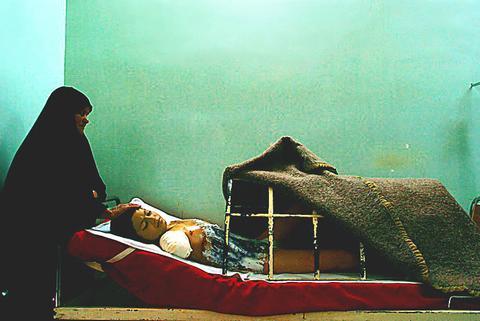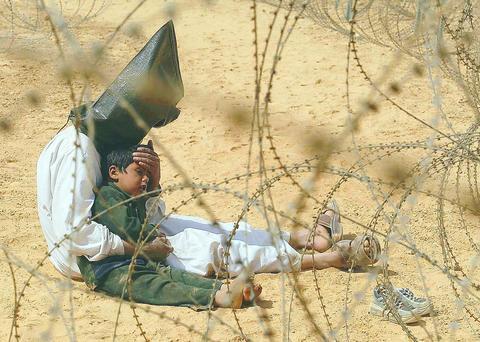While US President George W. Bush is facing a mounting crisis after the release of photos of his soldiers' barbaric behavior toward their Iraqi captives, a moment showing a simple act of kindness by an American GI is making waves, albeit quietly, at the Eslite Gallery.
The grand prize winner of this year's World Press Photo Exhibition, by French AP photographer Jean-Marc Bouju, shows a hooded Iraqi soldier imprisoned behind barbed wire comforting his son. At first glance the image may not be that striking, but the story behind it is.

PHOTO COURTESY OF WORLD PRESS PHOTO EXHIBITION
A compassionate US soldier saw that when the Iraqi man was being arrested his son became upset, so he allowed the boy to accompany his father. His father was also released from his handcuffs while in custody.

PHOTO COURTESY OF WORLD PRESS PHOTO EXHIBITION
Judges in the Amsterdam-based foundation's contest were swayed by the simple act of hope during the brutality of war. "Photojournalists have the power to show both the horrors of war and the compassion of humanity during war, we chose compassion," they said in an introduction to the work.
Conflicts in Iraq, Chechnya and Liberia along with the Bam earthquake figure most prominently in what some might find a shocking display.

PHOTO COURTESY OF WORLD PRESS PHOTO EXHIBITION
But because the brutality of humanity figures so notably, visitors to the show will be soothed somewhat by the sounds of the gospel hymn Amazing Grace playing softly in the background. Purists may argue against it, but it does take the edge off things.
Palestinian lensman Ahmed Jadallah's close-up photo of a bomb blast victim was taken shortly before he himself passed out, due to a severed artery in his leg that he suffered in the same blast. After the explosion, he instinctively picked up his camera and shot the aftermath. He is still recovering from his wounds. His picture took first place in the news-singles category.
Australian Philip Blenkinsop's photos of desperate Hmong guerillas, forgotten allies in the US' secret war in Laos, will remain largely forgotten. Only hundreds remain of the thousands who supported the US after it ended its involvement in the country.
Stellar LA Times photographer Carolyn Cole's beautiful yet haunting images again garnered multiple awards this year, including the Pulitzer.
Her stylized images of corpses in a Liberian mass grave were mistaken by one visitor for a fashion shot, the bodies sprinkled with lime wouldn't look out of place in a glamor magazine. Another moving composition was of a grieving Iraqi family who had three family members killed by US marines.
Russian photographer Yuri Kozyrev won for picturing the suffering in Iraq, which included one subtle pic of a man carrying an empty casket, obviously used before as it showed the stains of dried blood.
Once you get past all the war pictures, there are some gems that show the brighter side of humanity. Sports images range from a humorous shot of an upside-down French rugby player trapped hopelessly in a scrum to a fascinating look at a Colombian rodeo.
Elsewhere, Danish shooters have continued their strong tradition of stylized and contrast-heavy black-and-white reportage images. Newspapers there with their large budgets often send photographers to the world's trouble spots at a moment's notice. Erik Refner, who won the contest as a student two years ago with his image of an Afghan infant being prepared for burial, picked up awards in two different categories this year.
Canadian Paul Nicklen's colorful story on salmon netted first prize in the nature-stories category.
While most of the news pictures centered on war, one SARS image was awarded a prize. Third prize in the daily-life category went to Wuhan Daily News photographer Qiu Yan.
The photo shows a wedding party crossing a street, wearing masks. The newspaper, however, ended up in court because of the picture, which according to some was staged. Reports suggest the subjects of the photo are suing the photographer for payment.
The supposed couple said they were employees at a store.
World Press Photo officials say they are gathering information on the controversy to see whether or not they need to make a statement on the matter.

The canonical shot of an East Asian city is a night skyline studded with towering apartment and office buildings, bright with neon and plastic signage, a landscape of energy and modernity. Another classic image is the same city seen from above, in which identical apartment towers march across the city, spilling out over nearby geography, like stylized soldiers colonizing new territory in a board game. Densely populated dynamic conurbations of money, technological innovation and convenience, it is hard to see the cities of East Asia as what they truly are: necropolises. Why is this? The East Asian development model, with

June 16 to June 22 The following flyer appeared on the streets of Hsinchu on June 12, 1895: “Taipei has already fallen to the Japanese barbarians, who have brought great misery to our land and people. We heard that the Japanese occupiers will tax our gardens, our houses, our bodies, and even our chickens, dogs, cows and pigs. They wear their hair wild, carve their teeth, tattoo their foreheads, wear strange clothes and speak a strange language. How can we be ruled by such people?” Posted by civilian militia leader Wu Tang-hsing (吳湯興), it was a call to arms to retake

This is a deeply unsettling period in Taiwan. Uncertainties are everywhere while everyone waits for a small army of other shoes to drop on nearly every front. During challenging times, interesting political changes can happen, yet all three major political parties are beset with scandals, strife and self-inflicted wounds. As the ruling party, the Democratic Progressive Party (DPP) is held accountable for not only the challenges to the party, but also the nation. Taiwan is geopolitically and economically under threat. Domestically, the administration is under siege by the opposition-controlled legislature and growing discontent with what opponents characterize as arrogant, autocratic

Desperate dads meet in car parks to exchange packets; exhausted parents slip it into their kids’ drinks; families wait months for prescriptions buy it “off label.” But is it worth the risk? “The first time I gave him a gummy, I thought, ‘Oh my God, have I killed him?’ He just passed out in front of the TV. That never happens.” Jen remembers giving her son, David, six, melatonin to help him sleep. She got them from a friend, a pediatrician who gave them to her own child. “It was sort of hilarious. She had half a tub of gummies,